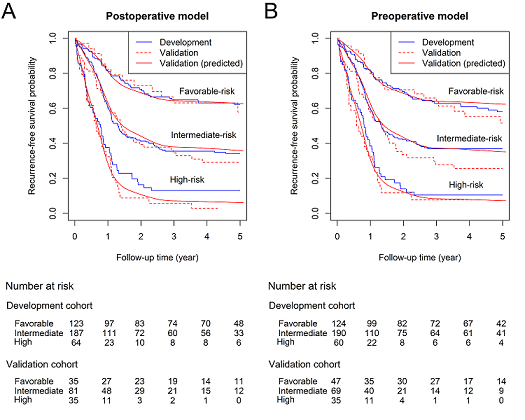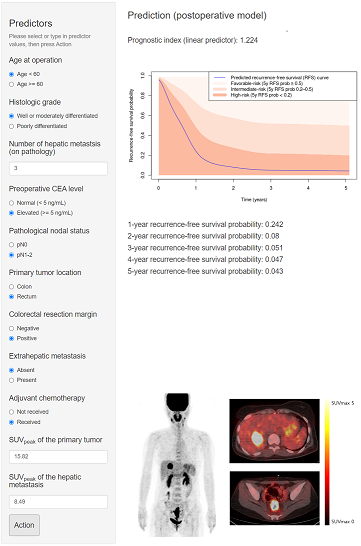글로벌 연구동향
핵의학
- [Eur Radiol .] FDG metabolic parameter-based models for predicting recurrence after upfront surgery in synchronous colorectal cancer liver metastasis
울산의대 /권현우, 이효상*
- 출처
- Eur Radiol .
- 등재일
- 2023 Mar
- 저널이슈번호
- 33(3):1746-1756.
- 내용
Abstract
Objective: This study aimed to develop and validate post- and preoperative models for predicting recurrence after curative-intent surgery using an FDG PET-CT metabolic parameter to improve the prognosis of patients with synchronous colorectal cancer liver metastasis (SCLM).Methods: In this retrospective multicenter study, consecutive patients with resectable SCLM underwent upfront surgery between 2006 and 2015 (development cohort) and between 2006 and 2017 (validation cohort). In the development cohort, we developed and internally validated the post- and preoperative models using multivariable Cox regression with an FDG metabolic parameter (metastasis-to-primary-tumor uptake ratio [M/P ratio]) and clinicopathological variables as predictors. In the validation cohort, the models were externally validated for discrimination, calibration, and clinical usefulness. Model performance was compared with that of Fong's clinical risk score (FCRS).
Results: A total of 374 patients (59.1 ± 10.5 years, 254 men) belonged in the development cohort and 151 (60.3 ± 12.0 years, 94 men) in the validation cohort. The M/P ratio and nine clinicopathological predictors were included in the models. Both postoperative and preoperative models showed significantly higher discrimination than FCRS (p < .05) in the external validation (time-dependent AUC = 0.76 [95% CI 0.68-0.84] and 0.76 [0.68-0.84] vs. 0.65 [0.57-0.74], respectively). Calibration plots and decision curve analysis demonstrated that both models were well calibrated and clinically useful. The developed models are presented as a web-based calculator ( https://cpmodel.shinyapps.io/SCLM/ ) and nomograms.
Conclusions: FDG metabolic parameter-based prognostic models are well-calibrated recurrence prediction models with good discriminative power. They can be used for accurate risk stratification in patients with SCLM.
Key points: • In this multicenter study, we developed and validated prediction models for recurrence in patients with resectable synchronous colorectal cancer liver metastasis using a metabolic parameter from FDG PET-CT. • The developed models showed good predictive performance on external validation, significantly exceeding that of a pre-existing model. • The models may be utilized for accurate patient risk stratification, thereby aiding in therapeutic decision-making.


Affiliations
Hyo Sang Lee 1, Hyun Woo Kwon 2, Seok-Byung Lim 3, Jin Cheon Kim 3, Chang Sik Yu 3, Yong Sang Hong 4, Tae Won Kim 4, Minyoung Oh 5, Sangwon Han 5, Jae Hwan Oh 6, Sohyun Park 7, Tae-Sung Kim 7, Seok-Ki Kim 7, Hyun Joo Kim 2, Jae Young Kwak 8, Ho-Suk Oh 9, Sungeun Kim 2, Jung-Myun Kwak 10, Ji Sung Lee 11, Jae Seung Kim 5
1Department of Nuclear Medicine, GangNeung Asan Hospital, University of Ulsan College of Medicine, 38 Bangdong-gil, Sacheon-myeon, Gangneung-si, Gangwon-do, 25440, Republic of Korea. leehs75@gnah.co.kr.
2Department of Nuclear Medicine, Korea University College of Medicine, Seoul, Republic of Korea.
3Department of Surgery, Asan Medical Center, University of Ulsan College of Medicine, Seoul, Republic of Korea.
4Department of Oncology, Asan Medical Center, University of Ulsan College of Medicine, Seoul, Republic of Korea.
5Department of Nuclear Medicine, Asan Medical Center, University of Ulsan College of Medicine, Seoul, Republic of Korea.
6Center for Colorectal Cancer, Research Institute and Hospital, National Cancer Center, Goyang, Republic of Korea.
7Department of Nuclear Medicine, Research Institute and Hospital, National Cancer Center, Goyang, Republic of Korea.
8Department of Surgery, GangNeung Asan Hospital, University of Ulsan College of Medicine, Gangneung, Republic of Korea.
9Division of Hemato-oncology in the Department of Internal Medicine, GangNeung Asan Hospital, University of Ulsan College of Medicine, Gangneung, Republic of Korea.
10Department of Surgery, Korea University College of Medicine, Seoul, Republic of Korea.
11Clinical Research Center in the Asan Institute for Life Sciences, Asan Medical Center, University of Ulsan College of Medicine, Seoul, Republic of Korea.
- 키워드
- Colorectal neoplasms; Fluorodeoxyglucose F18; Liver neoplasms; Positron emission tomography; Prognosis.
- 연구소개
- 대장직장암 동시 간 전이 환자에서 대장직장암과 간 전이에 대해 즉시 수술을 하였을 때 재발을 예측하는 모형을 FDG PET 상의 종양대사인자를 중요 예측변수 중 하나로 사용하여 개발하고 다기관 검증한 논문입니다. 대장직장암 동시 간 전이는 병기 4의 암이지만 절제가능한 경우 수술적 절제로 완치까지 바라볼 수 있는 질환입니다. 하지만 완전 절제를 받은 환자에서도 60~70% 가량은 재발하는 것으로 알려져 있어, 예후에 근거한 수술 환자군 선택을 할 수 있도록 예후예측 도구 개발이 시급한 상황입니다. 본 연구에서는 FDG PET 상에서 측정할 수 있는 종양대사인자를 주요 예측변수의 하나로 포함하는 재발예측 모형을 구축하여, 다기관 검증하였습니다. 구축 모형은 기존의 임상병리학적 모형 대비 우수한 성능을 보였습니다. 구축한 모형은 웹 앱 형태로 배포하여 사용하기 편하도록 하였습니다. 본 연구는 진료현장에서 임상적 의사결정 뿐 아니라 전향적 연구에서 환자군 설정 등 임상연구에도 유용할 것으로 생각됩니다.
- 덧글달기










편집위원
Synchronous colorectal cancer liver metastasis (SCLM) 환자에서 18F-FDG PET/CT에서 구한 MTV로 재발을 예측하는데 유용함을 보여준 다기관 후향적 임상연구임. 이러한 연구결과는 대장암 관련 의사 및 핵의학 임상가에게 관심을 끌 흥미로운 연구로 생각됨.
2023-05-08 16:57:00